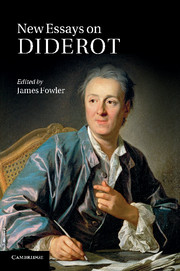Book contents
- Frontmatter
- Contents
- Notes on contributors
- Acknowledgements
- List of abbreviations
- Introduction
- PART I DIDEROT THE PHILOSOPHE
- 1 Diderot and the ancients
- 2 Diderot's earlier philosophical writings
- 3 The Encyclopédie: innovation and legacy
- 4 Diderot, Rousseau and the art of craft
- 5 Diderot's anti-colonialism: a problematic notion
- 6 Diderot's letters to Sophie Volland
- PART II NOVELS
- PART III DIALOGUES
- PART IV PLAYS AND DRAMATIC THEORY
- PART V MUSIC, PERFORMANCE, AESTHETICS
- Select bibliography
- Index
6 - Diderot's letters to Sophie Volland
Published online by Cambridge University Press: 11 April 2011
- Frontmatter
- Contents
- Notes on contributors
- Acknowledgements
- List of abbreviations
- Introduction
- PART I DIDEROT THE PHILOSOPHE
- 1 Diderot and the ancients
- 2 Diderot's earlier philosophical writings
- 3 The Encyclopédie: innovation and legacy
- 4 Diderot, Rousseau and the art of craft
- 5 Diderot's anti-colonialism: a problematic notion
- 6 Diderot's letters to Sophie Volland
- PART II NOVELS
- PART III DIALOGUES
- PART IV PLAYS AND DRAMATIC THEORY
- PART V MUSIC, PERFORMANCE, AESTHETICS
- Select bibliography
- Index
Summary
The Letters to Sophie Volland are a documentary record of Diderot's relationship with Louise-Henriette Volland (1716–84), whom the philosophe decides to call ‘Sophie’, a name evoking wisdom. As Sophie's own letters have disappeared without trace, this correspondence can seem like a long monologue on Diderot's part, a drawn-out plaint from the man of letters who has fallen in love, an extended apostrophe. Jacques Chouillet uses the striking phrase ‘un dialogue à une voix’ (‘a one-voice dialogue’) to describe the collection. To add to this effect, history records almost nothing about Louise-Henriette. Trousson is only able to furnish the sparsest of details. He notes: ‘[elle] était fille d'un avocat au Parlement de Paris, ensuite directeur des gabelles – l'impôt sur le sel’ (‘she was daughter of a lawyer at the Paris parlement, who went on to become director of gabelles – the salt tax’), adding that Diderot remembers her mother's maiden name (Carlière) when he writes one of his short stories. So we have no choice but to follow the example of Odile Richard-Pauchet and reconstruct ‘Sophie’ from the image which Diderot has bequeathed in his correspondence. His object of love is also his ideal addressee: ‘Épistolière esthète et philosophe à ses heures, lectrice enthousiaste d'une œuvre qui n'a pas donné toute sa mesure, sensible et indépendante, telle est Sophie.’ (‘A letter-writer capable of being an aesthete and a philosopher; the enthusiastic reader of a work that has not yet fully blossomed; sensitive and independent: such is Sophie.’)
- Type
- Chapter
- Information
- New Essays on Diderot , pp. 86 - 98Publisher: Cambridge University PressPrint publication year: 2011

